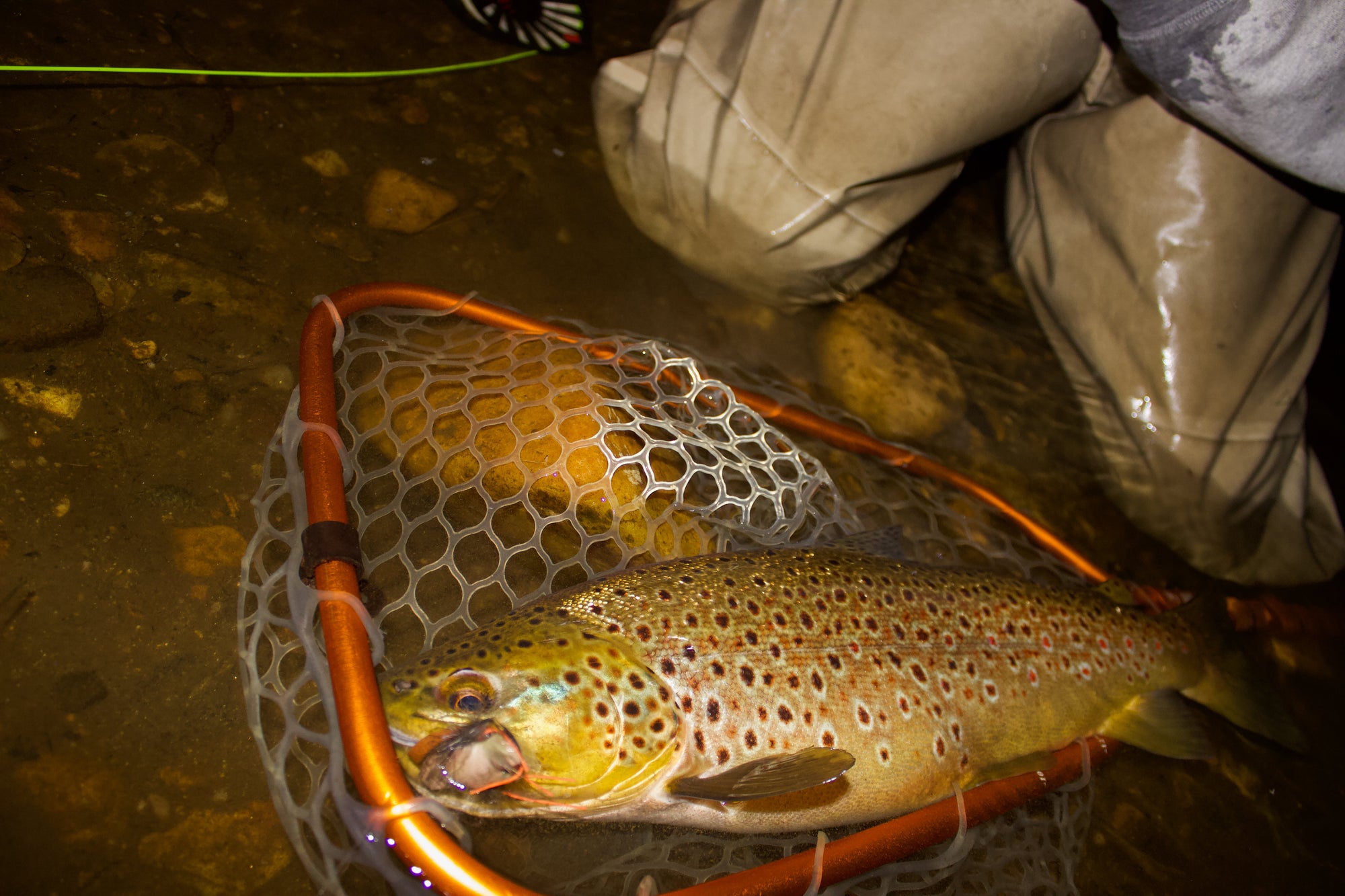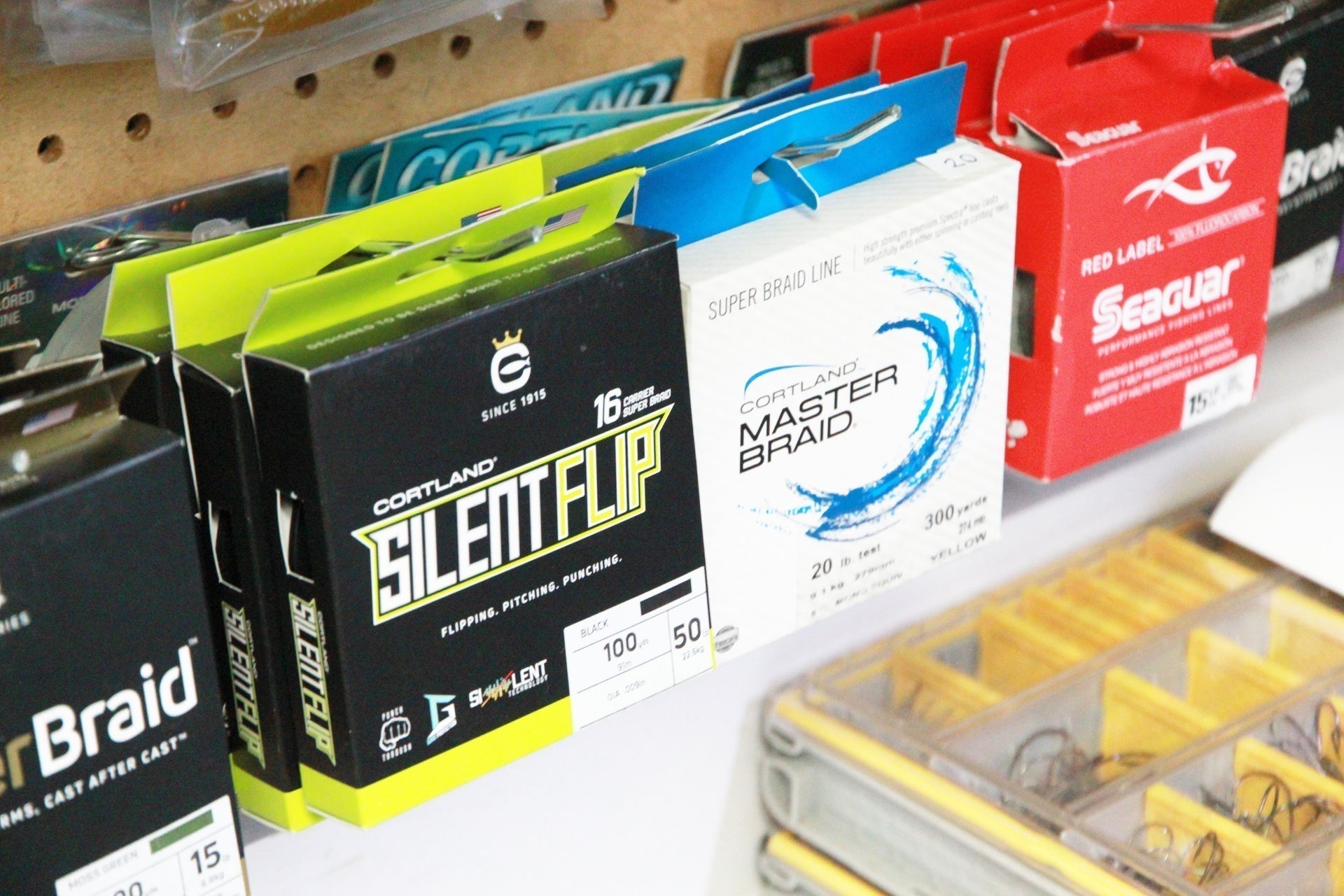Article Written by Mike Komara. Learn More About the Author Below / Article Read Time 6 Minutes
Although the night fishing learning curve can be steep due to low numbers of fish and unusual tactics, it can be extremely rewarding when you finally find a trout that goes bump in the night. The biggest thing you have to realize is that the river is a whole different place after dark. Pools and flats that seem devoid of life outside of hatch time in the day will come alive when the sun sets. Fish that are holding in deeper water, weeds, and undercut banks during the day, feel safe enough to travel to these more productive areas to feed at night. I’ve seen plenty of fish over the two-foot mark sitting in six to eight inches of water, waiting for baitfish or frogs to swim by. You have to throw a lot of knowledge of targeting trout in the day time out the window and change your mindset about where the fish are going to be at night. My rule of thumb is that at night, you want to fish some of the water that you would usually avoid during the daytime. Prime areas to me are slow flats (water moving roughly walking pace) where the average depth is about knee deep on the wading side and knee to waist deep on the side you're casting to. Though I’m usually alone, the best way to night fish is with a friend. It makes it easier to run through tactics and helps calm the nerves a bit.

In general, the worse the fishing conditions are for catching big trout in the daytime, the better they are for catching them at night. When late summer conditions peak, the fish become what I refer to as temporally concentrated, being forced to all feed in small, specific sections of time. On hot, sunny days when there’s minimal bug activity and the water is at its lowest, the best fish in the river are going to wait until the cover of darkness to come out and feed en masse. This is the best time to be out at night because you have more willing targets to put your fly over. Be careful fishing these times though, if your river is too hot to fish in the day it’s not safe to fish at night either, even if the temps come down.

On most nights, there will be a half to one-and-a-half-hour window of heavier feeding activity where light, water temperature, air pressure, cloud cover, and bait activity line up to get the fish going. In my experience, the timing of this window has the most to do with light. The darker it is, the safer the fish feel and the better the fishing can be. I have had great nights during full moons and visible conditions as well but I always try and plan my trips around cloudy nights, new moons, before moonrise, or after moonset. The biggest trout usually won’t start eating until they feel it’s dark enough to safely come out of hiding. If it’s been cloudy and dark all day, the window can be as early as dusk. If it’s been hot and sunny all day with a full moon and no clouds, the window might not be until three or four AM, and the fishing might never get good. In these conditions, I may even go to sleep early and wake up around two AM to get out for a “morning” night session. All that being said, the bite window depends on a number of factors. It could happen at peak full moon, or it may not happen at all in perfect conditions. There will also usually be a few trout feeding out of the main window, so there will be some fish that bite throughout the night. It’s nearly impossible to truly time it, but the more you get out there and night fish, you will start to pick up on particular patterns that will help you plan future trips around certain factors.

My usual nighttime setup is simple: a seven weight rod and reel, the Cortland floating streamer series line, and an aggressive five foot tapered leader tipped with Cortland Ultra-Premium 0X Fluorocarbon tippet or fluorocarbon leader material. While fishing at night, line stealth becomes less of a factor so don't be afraid to tip your leader with 16 lb - 20 lb leader material. There are endless ways to fool trout at night, but the best to start with is probably mousing. That may not be the best term, since I think fish usually take these flies as a frog or some sort of wounded baitfish instead of a mouse, but we’ll roll with it. “Mouse” flies give off a large, visible wake that makes them possible to track in the dark. This feedback is important when you’re new to the game, and helps you visualize the speed, path, and action of your fly. There’s also nothing better than a topwater blow up on a calm night. Stay away from the deer hair style patterns and opt for something like a Mr. Hanky or Lynch’s white belly mouse. These patterns have more drag and ride a little lower, which seems to increase strikes and hookup percentage. I usually cast directly across stream or quartering down, and always attempt to put the fly as close to the bank as possible. It’s hard to gauge distance in the dark, so plan on getting caught on the opposite bank a few times. If I lose track of where I am or how far I need to cast, I’ll briefly flash my light on a low setting upstream of where I’m headed to get my bearings. I try and play around with retrieves, but I have had the most success with very slow twelve to twenty-four inch pulls with one or two second pauses.

When topwater patterns aren't getting it done, I’ll swing streamers a few inches under the surface instead. I fish these the same way as the mouse, sometimes with a harder pull mixed into the slow retrieve to mimic a wounded fish getting a burst of energy. I like neutrally buoyant flies that ride two to six inches under the surface. I think it's important to fish high in the water column, so the trout can see the silhouette of the fly against the sky. So far, my favorite patterns for this tactic are bulky marabou streamers and trout Buford’s in black. If I need to change flies, I’ll use the light of my headlamp or phone screen to discreetly tie on a new fly in my pack or facing the opposite way of where I am casting to.

With both top water and subsurface tactics, you have to be ready for a strike at all times. If your fly is in the water, it’s vulnerable to being eaten. I have had fish eat when I’m walking from spot to spot or headed back to the bank, and my biggest fish actually came when I was dangling my fly in the water deciding what pattern to change to. When a fish does decide to eat at night, you have to set carefully. When you hear a fish eat, don’t strip set until you feel its weight on the line. I believe that you hear the sound of the fish breaching the water before it actually gets to the fly and eats. On top of this, with top water flies especially, a number of strikes you get are not eats, but the trout slashing or hitting the fly to get it out of their territory or stun it. If you strip set on these, the fish usually won’t come back to eat. When this happens, I drop the rod tip and take a few steps downriver to let the fly dead drift like stunned prey, then give it a slight twitch when the line comes tight again. Sometimes the fish will come back to actually eat and give you a real shot at putting a hook in it. When you connect with a fish, fight it hard and fast. Only use your light if its big enough to be worth it, and turn away from the water you are looking to target when you do.
There’s a lot that goes in to catching trout at night, but that’s one of the things that makes it fun. It’s like fishing a whole new river with a different set of rules to learn. It’s also lines you up for a very good chance at catching a true trophy trout and can be an effective way to catch quality fish in pressured rivers. You have to adjust your approach and expectations. On a river where you may catch thirty fish in the day, you’ll probably get less than five at night. But when you mix the size of the fish, the aggressive eats, the adrenaline of trying to land a two footer in the dark, and sprinkle in a little fear of bears and bigfoot, it makes an experience well worth the time.
About the author
Mike Komara is a college student, guide and competitive angler from Pittsburgh, PA. He began fly fishing at the age of eight years old and eventually found himself on the US Youth Fly Fishing Team. He was added to the worlds team from 2017-2019 and was made the team captain in 2019. He has fished three world championships in Slovenia, Poland, and the Czech Republic with a great group of teammates, that were fortunate enough to bring home bronze and silver medals from two. He currently attends Penn State studying materials engineering and focuses much of his time on hunting big trout and musky.
To book a guided trip or find out more about Mike check out his website here:
Products mentioned in this article:
Floating Streamer Line
Fluorocarbon Leader Material
Ultra Premium Fluorocarbon Tippet


